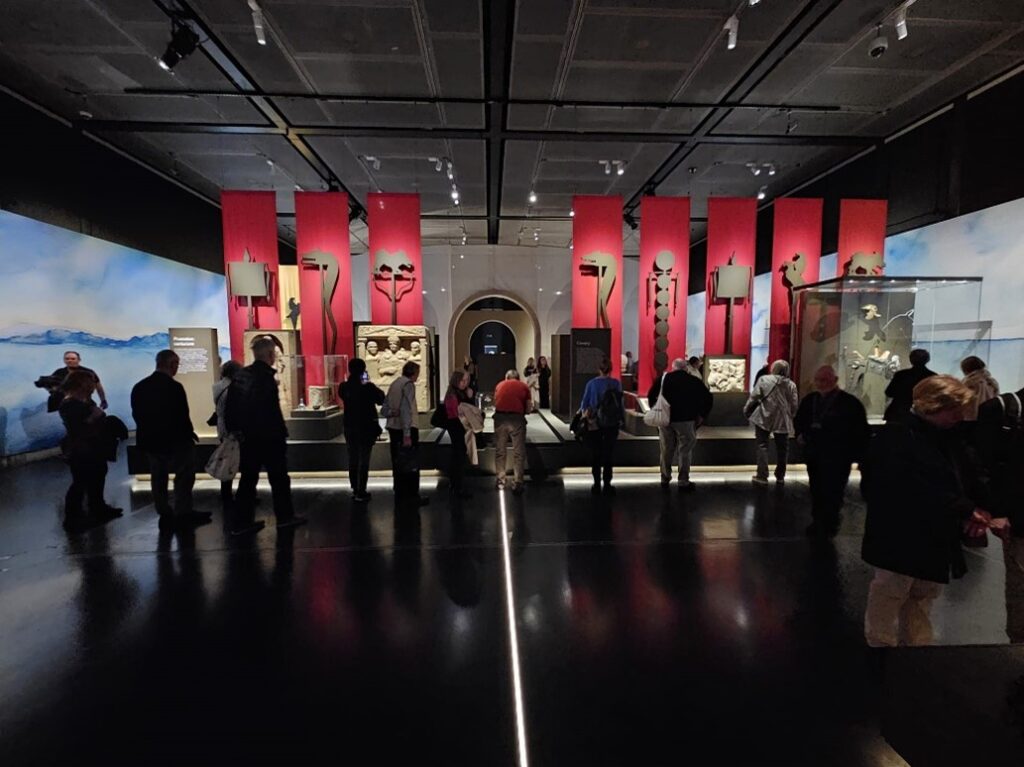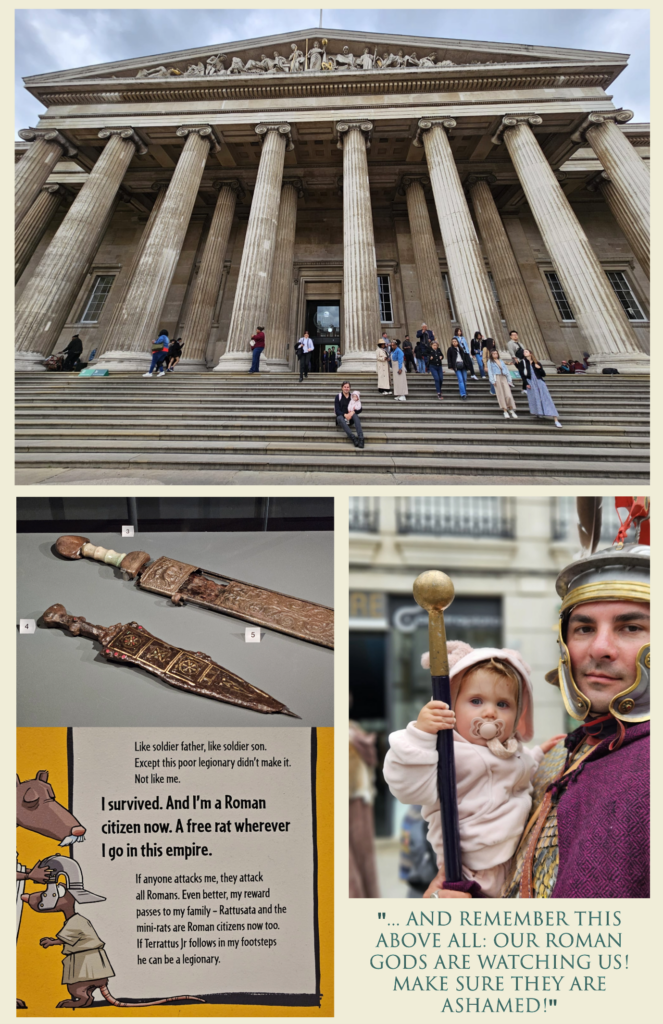Dedication to the LEGION exhibition (Ioan Opera, Romania, ITP 2019)
Written by Ioan Oprea, Conservator, National Museum of The Union, Romania (Romania, ITP 2019)

My name is Q. K. Dasivs.
I am a Roman legionnare serving in the province of Dacia for nearly 14 years. I am optio, second in command of the first centuria, first cohort, in Legio I ADIVTRIX, for seven years. Before this, I served in the same position in legio XIII Gemina, for six years.
The world has many amazing places, but only one is called ”The Eternal City”, making it since the beginning God’s place on Earth. There are nearly three millennia since the Roman Empire and its legacy is still amazing us and is still influencing our lives in various ways.
To me, Rome and the Roman legacy is something different; it’s a study field, a lifestyle, a hobby and a pillar around which I have constructed big parts of my life for the last 14 years. I have dedicated, during these years, a lot of time to the Roman reenactment idea; reenactment here is like trying to create a time machine and see for yourself how it was back then, to immerse yourself and feel different aspects of Roman ancient times.
This “movement” is huge in Europe, with thousands of people involved and dozens of cities supporting them into rediscovering the past. And it’s also old; in fact, when referring to it, we have to remember it was the Romans themselves who made reenactment 2000 years ago. The Eternal City held big celebrations in honour of its victories and, later, the Colosseum was hosting great battle recreations, displaying real soldiers and fights in which, of course, the Roman team were victorious. Today, reenactment is used as an interactive and cultural tool, to link cities, to rediscover heritage, to signal the presence of sites and make people aware of them. It is used to teach history and offers a new interesting way of spending time, to train or to work as the Romans did back in their time. As I said, I dedicated so much time to this field so that in 2015, when my wedding was coming, I made wedding invitations with my Roman name, Dasius, on them, because most of the people didn’t knew who Ioan was!! The wedding was, of course, in Roman style, being the first ‘Roman’ wedding in Apulum for nearly two millennia.

I took a generous introduction here because this blog is about a Roman event and it is about the Romans. In the ancient writings, such as in Caesar’s case, for example, we would see such an event described as being a disadvantage to the Romans, just to carefully follow the idea of the Romans only winning in the field. I wanted to follow a similar idea here, but not strictly as the mentioned one, but I added my story, my real story, only to highlight the creation of the LEGION exhibition, it’s impact, it’s interest in the international audience and it’s impact on people’s activities across the globe.
I am very grateful and happy again to thank Claire for giving me the opportunity to travel to the British Museum and see for myself the famous LEGION exhibition. Being in the reenactment field for so long, I must say it was one of the most popular events I have seen online, with hundreds of shares, likes, photos and comments. At some point it became a ”must see thing” among the fellow reenactors and I have seen many of them travelling to London for it. It was a success; I used to say that before seeing it for myself, and also after I visited it. Thanks to Claire, this visit took place in June and it was a beautiful opportunity to be back at the British Museum and also to remember some of the best moments of my life from the 2019 ITP.
Just before visiting LEGION, George welcomed us and we had some time to catch up with the latest news from ITP and remember some of the old memories. Evelyn, our daughter, also joined me and Octavia and it was her first meeting with the British Museum and with the ITP; she is the youngest Roman from our group now. From London we travelled to Lugo, for the international Roman festival, ARDE LVCVS, so our trip was all Roman from the beginning to the returning day, and before any event, strong preparation is needed.

Seeing LEGION was just great!

Having so many ideas in my mind, I will try to highlight some of them because I saw it with different eyes, from different points of view. Even when I have to talk to a public event about the Romans, in my mind, there is a competition of ideas and I must make a selection of them, otherwise the lines would just go one after another. I imagine there was a great stress in organising such a complex exhibition and the demands were also huge. The Roman world is incredibly large and to gather some of it’s gems, to display them in a space, from the richest collections across Europe, I am sure everyone agrees this was not a simple task. I would say LEGION was a collection of gems: rare artifacts some of which I have only seen in catalogues or books; some of the artifacts were just unique and new and everyone wanted to see them. Such example is the unique finding and new type of lorica segmentata coming from Kalkriese, Germany.

I had the amazing chance to be in Kalkriese, at their Roman Festival, when this lorica was discovered and first announced to the public. In the first photo I am wearing the classical type of lorica segmentata; this new type is easier to equip and offers a larger movement of hands while training or fighting.
As a conservator, just seeing the fabulous Dura-Europos shield was nearly breathtaking. This is the only shield that survived from the ancient times and there were hundreds of thousands of such items. Only this, in a rare set of circumstances, survived.


The responsibility for the microclimate conditions is huge for such an artifact like this, to preserve the wood structure, the leather and the fabulous painting. A few years ago, I have made the first reconstruction of this shield in Romania; it took a lot of hard work to make it and I was happy for the chance to see the original now and to know what to adjust for the second version I will make.
The exhibition continues with precious artifacts and I will stop myself, but not before mentioning some other few, general, ideas about LEGION. I must say I was happy to see such a friendly exhibition – clear and accurate. A person who is not so familiar with the Roman world would have found a clear narrative, a path to follow into the exhibition and discover all the life aspects of a man, 2000 years ago, eager to join the army from various reasons. Step by step, accompanied by artifacts with their stories of military life, one would discover the status of a man, the conditions he was supposed to have in order to join the army, his daily duties, his needs on the battle field and for regular daily life, his missing of home and dear ones, his expectations after finishing the 25 years of service and so on. Each step was illustrated by the metamorphosed character, Terratus, a lovely friend who simply explained all that was in front of you, like the size of a legion, the military medals, the main weapons such as gladius and pugio (sword and dagger), the Roman artilleries and cavalry etc. This exhibition was the story of the 25 military years of service of someone who lived and died 2000 years ago. What a complex job just to imagine all the details that composed this exhibition, what a great selection of thematic artifacts to create the fluency of the idea.

Legion had something for everyone who visited it, for specialists and amateurs alike and I am sure everyone who saw it would give a big round of applause for the organising team and for the British Museum for supporting such a rare and monumental exhibition.

